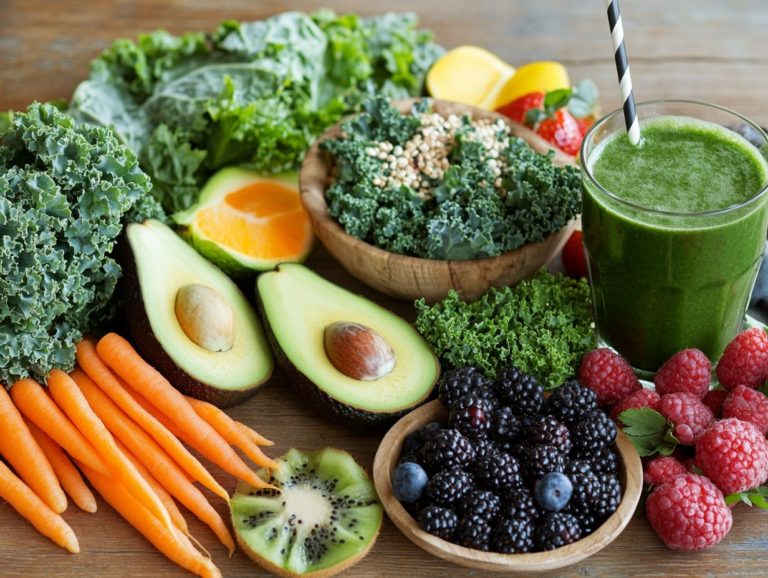How to Cultivate a Positive Food Environment
Creating a positive food environment is vital for encouraging healthy eating habits and enhancing your overall well-being.
This article explores how your surroundings influence your food choices and provides practical tips to set the stage for nutritious eating.
You ll discover strategies to promote mindful eating being aware of what you eat and how it makes you feel tackle negative influences, and sustain positive changes for the long haul.
Explore with us as we reveal how to create an environment that truly supports your health goals.
Contents
- Key Takeaways:
- Understanding the Importance of a Positive Food Environment
- Creating a Positive Food Environment
- Incorporating Healthy Habits
- Dealing with Negative Influences
- Maintaining a Positive Food Environment
- Frequently Asked Questions
- What is a positive food environment?
- Why is it important to cultivate a positive food environment?
- How can I improve my personal eating habits?
- What are some ways to create a positive food environment at home?
- How can I create a positive food environment in my workplace?
- What strategies can I use to promote a positive food environment for my children?
- How can I overcome challenges in creating a positive food environment?
Key Takeaways:
A positive food environment is key to healthy eating.
Practical tips such as meal planning and keeping healthy snacks readily available can help create a positive food setting.
Maintaining mindful eating practices and addressing negative influences can help sustain a positive food environment for long-term success.
Understanding the Importance of a Positive Food Environment
A positive food environment is essential for encouraging healthy eating habits and enhancing public health. It includes a blend of physical, social, and economic factors that shape food choices in diverse settings think schools, hospitals, and community spaces.
By creating supportive food settings, you can dramatically boost nutrition standards. This includes ensuring that healthier food options are readily available, promoting mindful eating practices, and fostering a constructive relationship with food.
Community support is crucial in sustaining these efforts and plays a vital role in preventing obesity and improving health outcomes for individuals of all ages.
Impact on Eating Habits and Overall Health
The impact of food environments on your eating habits is profound. They shape the choices you make about meals and snacks, ultimately influencing your overall health.
In both urban and rural settings, the presence or absence of healthy options greatly affects your dietary patterns. For example, if you live in an area abundant with supermarkets and farmers’ markets, you re likely to enjoy access to fresh produce and whole grains, encouraging healthier eating habits.
Conversely, if your surroundings are filled with fast-food outlets and convenience stores, you may find your nutritious options are quite limited, leading to less-than-ideal meal choices. Effective meal planning can be difficult due to a lack of knowledge or resources, making food assessments essential.
These evaluations highlight the quality and accessibility of food options available to you, enabling communities to implement necessary changes that promote better health outcomes.
Creating a Positive Food Environment
Creating a positive food environment means implementing effective strategies in both food retail and food service settings.
This is your opportunity to promote healthy choices and nurture a positive relationship with food for your consumers.
By thoughtfully designing these experiences, you can truly enhance their connection to food and well-being.
Practical Tips for Setting the Scene

Setting the scene for a positive food environment requires easy-to-implement tips across various community settings to encourage healthy choices and sustainable practices.
Integrating effective food marketing strategies can influence consumer behavior and raise awareness about the benefits of nutritious options.
Initiatives like farmers’ markets and local food programs not only provide access to fresh produce but also strengthen community ties, creating a vibrant support network.
Enhancing food service operations by including healthier dishes and clearly displaying nutritional information can elevate your offerings.
Each of these elements plays a crucial role in guiding you and others toward better food choices, ultimately fostering a culture of health and well-being for everyone involved.
Incorporating Healthy Habits
Incorporating healthy habits into your daily routine is vital for cultivating a culture of mindful eating and portion control.
This approach enhances your overall health and nurtures a preference for healthier foods and beverages, paving the way for improved well-being.
Promoting Mindful Eating and Portion Control
Promoting mindful eating and portion control is essential for healthy eating patterns. This is especially true in places like schools and hospitals, where individuals are encouraged to make informed choices.
By implementing strategies such as clearly labeling portion sizes, offering smaller plates, and creating engaging nutritional education programs, these environments can profoundly influence dietary behaviors.
Such initiatives aim to enhance awareness around food choices, helping you recognize your body’s hunger signals. Incorporating visuals and interactive elements can elevate your meal experiences, making healthy options not just appealing but enticing. This approach also tackles public health issues like obesity and chronic disease.
Ultimately, fostering a culture of mindfulness around food consumption can lead to lasting positive changes in community health outcomes. This encourages you to embrace a healthier lifestyle.
Dealing with Negative Influences
Addressing negative influences, like aggressive food marketing and the abundance of unhealthy food options, is crucial for enhancing community health and furthering obesity prevention initiatives.
By tackling these challenges head-on, you can make a significant impact on fostering a healthier environment for everyone.
Identifying and Addressing Triggers

Identifying and addressing the triggers that lead to unhealthy food choices is essential for creating an environment where healthy options can flourish.
By conducting thorough food assessments, you can uncover the specific factors influencing your eating habits, whether they stem from stress, social situations, or environmental cues. Recognizing these triggers enables you to make informed choices and underscores the vital role community support plays in your journey toward healthier living.
When communities unite to promote nutritious foods and share strategies for healthier eating, they establish a network that fosters positive behavioral changes. Here are some ways communities can come together:
- Workshops
- Cooking classes
- Community gardens
All these initiatives are designed to enhance food literacy and cultivate a space where nutritious options are readily available.
Maintaining a Positive Food Environment
Keeping a positive food environment requires ongoing commitment and effort! It s not just a one-time endeavor; it demands your commitment to sustainable practices, strict adherence to food guidelines, and strong community support.
This dedication is essential for promoting public health effectively.
Strategies for Long-Term Success
Implementing strategies for long-term success in maintaining positive food environments requires you to collaborate with various stakeholders, including food service providers, community organizations, and public health officials. This teamwork is essential for supporting healthy choices.
By fostering partnerships among these entities, you can help create sustainable initiatives that not only enhance access to nutritious foods but also educate residents about the benefits of healthier eating habits.
Take, for example, a local pilot program that unites schools and local farms. This initiative has successfully increased the availability of fresh produce in cafeterias while teaching students the importance of nutrition through hands-on gardening experiences.
Such collaborative efforts do more than just improve dietary choices they also enhance the overall well-being of the community. By working together, you can effectively lower rates of diet-related diseases and elevate the quality of life for all residents.
Frequently Asked Questions
What is a positive food environment?

A positive food environment is one in which healthy, nutritious food options are readily available and easily accessible, and where there is a supportive culture that encourages healthy eating habits.
Why is it important to cultivate a positive food environment?
A positive food environment has numerous benefits, including promoting healthy eating habits, preventing chronic diseases, and improving overall well-being and quality of life.
How can I improve my personal eating habits?
Improving your personal eating habits can be achieved by setting achievable goals, planning your meals, and making conscious food choices that prioritize nutrition.
What are some ways to create a positive food environment at home?
One way to create a positive food environment at home is by keeping a well-stocked fridge and pantry with healthy options such as fruits, vegetables, and whole grains.
Make it easier to choose healthy by keeping junk food out of reach!
How can I create a positive food environment in my workplace?
Encourage healthy potlucks and provide healthy snack options.
Promote regular breaks for employees to enjoy balanced meals. These strategies can make a big difference in workplace wellness!
What strategies can I use to promote a positive food environment for my children?
Get your kids involved now! When they help with planning and cooking, they re more likely to enjoy new foods.
Offer a variety of healthy options and limit access to unhealthy foods to further support their healthy choices.
How can I overcome challenges in creating a positive food environment?
Challenges like cost, time constraints, and picky eaters can make it tough.
Try budget-friendly healthy recipes, meal prepping, and involve picky eaters in meal planning to increase their interest in trying new foods.






